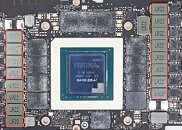- Joined
- Aug 19, 2017
- Messages
- 2,998 (1.07/day)
Rumors of NVIDIA's upcoming Ada Lovelace graphics cards keep appearing. With every new update, it seems like the total power consumption is getting bigger, and today we are getting information about different SKUs, including mobile and desktop variants. According to a well-known leaker, kopite7kimi, we have information about the power limits of the upcoming GPUs. The new RTX 40 series GPUs will feature a few initial SKUs: AD102, AD103, AD104, and AD106. Every SKU, except the top AD102, will be available as well. The first in line, AD102, is the most power-hungry SKU with a maximum power limit rating of 800 Watts. This will require multiple power connectors and a very beefy cooling solution to keep it running.
Going down the stack, we have an AD103 SKU limited to 450 Watts on desktop and 175 Watts on mobile. The AD104 chip is limited to 400 Watts on desktop, while the mobile version is still 175 Watts. Additionally, the AD106 SKU is limited to 260 Watts on desktop and 140 Watts on mobile.

Making a difference between a power limit and a TGP is essential. While the Total Graphics Power is what NVIDIA rates its GPUs to run at, the power limit represents the amount of power that can be applied by board partners and overclocking attempts. It is not necessarily translated into TGP, meaning the final TGP values should be significantly lower.
View at TechPowerUp Main Site | Source
Going down the stack, we have an AD103 SKU limited to 450 Watts on desktop and 175 Watts on mobile. The AD104 chip is limited to 400 Watts on desktop, while the mobile version is still 175 Watts. Additionally, the AD106 SKU is limited to 260 Watts on desktop and 140 Watts on mobile.

Making a difference between a power limit and a TGP is essential. While the Total Graphics Power is what NVIDIA rates its GPUs to run at, the power limit represents the amount of power that can be applied by board partners and overclocking attempts. It is not necessarily translated into TGP, meaning the final TGP values should be significantly lower.
View at TechPowerUp Main Site | Source







 90%. Making it one of the most efficient GPUs in the current generation. And with execution units going up massively in the next generation this trend will become even more obvious. I am no friend of high power consumption and I would like to see companies to limit power consumption on products right from the start but until politics or the majority of the market demands lower powerconsumption I will have to do this manually. I rather pay more for the product - using it 3-4 years - manually reducing the powerlimit to something i consider aceptable (max. 200W +/- 10%) and keep my power bill down while performance still goes up quite substanially, coming from a 175W RTX 2070.
90%. Making it one of the most efficient GPUs in the current generation. And with execution units going up massively in the next generation this trend will become even more obvious. I am no friend of high power consumption and I would like to see companies to limit power consumption on products right from the start but until politics or the majority of the market demands lower powerconsumption I will have to do this manually. I rather pay more for the product - using it 3-4 years - manually reducing the powerlimit to something i consider aceptable (max. 200W +/- 10%) and keep my power bill down while performance still goes up quite substanially, coming from a 175W RTX 2070.